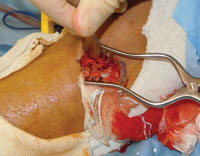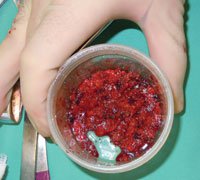The proximal tibia is an alternate harvest site with easy accessibility
Bone grafting is an essential component of restoring three-dimensional osseous architecture. Surgical correction of hard tissue deficiencies presents challenges in both the functional and aesthetic realms. Autogenous bone harvested from secondary surgical sites provides great utility in reconstructing defects, augmenting healing, treating nonunions, arthrodesis and lengthening bones. While a number of options are available in allograft, autograft and bone graft substitutes, the benefits of osteogenesis and osteoinduction in autografts, as well as its mechanical and handling characteristics, make it the gold standard.
Bone grafting procedures are used in an estimated 200,000 surgeries each year in the United States. The cellular and molecular elements that accompany the bony autograft serve multiple purposes. First, the osteoconductive scaffold recruits osteoprogenitor cells that make the grafting procedure more reliable and predictable. Second, a host of molecular growth factors that accompany autologous bone grafts have been evaluated and demonstrate osteoinductive qualities. These include fibroblast growth factor, transforming growth factor ß-1, vascular endothelial growth factor and the bone morphogenic proteins (BMPs). These factors are expressed at various times in the healing process and play an important part in fracture repair and new bone formation.
The most frequently used site of harvest is the iliac crest. Although bone from this area offers both cortical and cancellous bone, the procedure carries with it significant pain as well as risks of hematoma and paresthesia. With this in mind, other sites have been shown to be advantageous in terms of similar bone quantity, but less postoperative morbidity. Studies have shown that approximately 10 cm3 to 15 cm3 can be harvested from the proximal lateral tibia with low morbidity and easy accessibility.
Incision placement
This surgical technique addresses a method for harvesting cancellous bone from the lateral proximal tibia metaphysis.
|
|
|
|
|
Images: Mauffrey C |
The anatomy of the proximal lateral tibia facilitates access to the graft site. Critical areas to avoid are the tibialis anterior muscle, which will lie inferior to the harvest site. The incision is ideally placed between the delineation of the tibialis anterior muscle and the anterior subcutaneous surface of the tibia. Although the cutaneous branches of the lateral sural nerve and fibular nerve are in proximity to the graft site, one main advantage of the procedure is there are no major nerves over the harvest site. The main blood supply to possibly be encountered in the harvest area is the anterior tibial artery; however, experience shows this is rarely the case. We use the osseous anatomy to determine major landmarks and plan the incision. We highlight the lateral tibiofemoral joint line, the tibial tuberosity, the fibular head and Gerdy’s tubercle. The midpoint of a line that joins the fibular head to the tibial tuberosity approximates the location of Gerdy’s tubercle (Figure 1). Gerdy’s tubercle is where we start the incision and then carry the incision inferiorly and medially (Figure 2).
The positioning of the patient is determined by the graft recipient site. The optimal patient positioning is supine with a sand bag placed under the homolateral buttock to elevate and internally rotate the lateral aspect of the proximal tibia metaphysis. The patient may also be placed in a prone position with the leg flexed; however, this position makes the procedure much more difficult.
Intravenous antibiotics are given at induction before the tourniquet is inflated. The leg is prepared up to the mid-thigh with povidone-iodine (betadine) solution and draped in a sterile manner. Infiltration of approximately 0.25% marcaine (bupivicaine, AstraZeneca) with 1/200,000 of adrenaline is infiltrated into the area of the incision down to the periosteum to reduce postoperative pain and intraoperative bleeding.
Curette selection is critical
A linear incision of 2 cm to 3 cm is directed superolaterally to inferomedially through the skin and subcutaneous tissue directly over Gerdy’s tubercle. This assures the patellar tendon is medial, and the tibialis anterior muscle is inferior. This is continued through the skin and the subcutaneous tissue down to the periosteum, using care not to enter the muscle fibers of the tibialis anterior. The periosteum is then sharply incised and retracted to expose the lateral surface of the metaphysis at about the level of the tibial tuberosity. Care must be taken to make an incision long enough to avoid excessive traction on the skin while allowing enough access to begin the lateral bony window (Figure 3).
West retractors are applied, and a series of drill holes are made with a 2-mm drill bit forming a 1-cm2 area (Figure 4). The drill holes are joined together using a 0.25-inch osteotome removing a 1-cm2 window of bone. It is usually easiest to define the lateral osteotomies first, followed by the inferior osteotomy and then the superior osteotomy. Once the osteotome is driven past the cortex, the cortical bone can be easily out-fractured, aiding easy visualization of the inner cancellous bone. Usually we incorporate the crest of the tubercle, which allows us to reference an anatomic landmark for avoiding the articular surface of the tibia while maintaining access to the best metaphyseal bone. The cortical window is placed in a sterile sponge soaked in normal saline. The entire cancellous bone of the metaphysis is available to collect using a curette (Figure 5). We find that using the largest curette possible allows for easy harvesting of the cancellous bone, maintains integrity of the surgical site and makes perforation less likely. Ideally, the integrity of the bone window is kept intact while harvesting the cancellous bone (Figure 6). As stated, approximately 15 mL to 25 mL of cancellous bone can be harvested from this site (Figure 7). Depending on preoperative planning, the bone graft can be mixed with antibiotic powder. In general, one half to two thirds of a 1.2-g vial of tobramycin powder is mixed with the graft.
|
|
|
|
|
|
The incision is closed in two layers, and a sterile compressive dressing applied before leaving the operating room (Figure 8). This dressing is usually removed 24 hours after the procedure.
Postoperative management
Following the procedure, we allow weight bearing as tolerated. Alt and colleagues demonstrated in cadaveric studies where eight cadaver proximal lateral tibias were decancellated and compression studies were carried out with eight control lateral tibias. No difference was found, which supports the clinical findings that a sufficient amount of cancellous bone can be harvested from the tibia and the risk of postoperative fracture is not increased. We find that as the patients are allowed to function, their complaints of pain are minimal and generally resolve within 2 weeks to 4 weeks. Sutures are removed at 10 days, and the patients are instructed on local wound care.
The proximal lateral tibial metaphysis provides a useful site for autogenous bone harvesting. When compared to other sites, we find this approach preferable because of its relatively simple anatomy. The dissection is straightforward, even in obese patients. There is ample cancellous bone that may be harvested, which is comparable in quality and quantity to the anterior iliac crest. The patients tolerate it and recover well.
References:
- Alt V, Nawab A, Seligson D. Bone grafting from the proximal tibia. J Trauma Injury Inf Crit Care. 1999;47(3):555–557.
- Arrington ED, Smith WJ, Chambers HG. Complications of iliac crest bone graft harvesting. Clin Orthop. 1996;329:300–309.
- Burchardt H. Biology of bone transplantation. Orthop Clin North Am. 1987;18:187–196.
- Catone GA, Reimer BL, McNeir D, Ray R. Tibia autogenous cancellous bone as an alternative donor site in maxilla facial surgery: A preliminary report. J Oral Maxillofac Surg. 1992;50:1258–1263.
- Engelstad ME, Morse T. Anterior iliac crest, posterior iliac crest, and proximal tibia donor sites: A comparison of cancellous bone volumes in fresh cadavers. J Oral Maxillofac Surg. 2010;68:3015-3021.
- Kushner GM. Tibia bone graft harvest technique. Atlas Oral Maxillofacial. Surg Clin N Am. 2005;13:119-126.
- O’Keefe RM, Reimer BL, Butterfield SL. Harvesting of autogenous cancellous bone graft from the proximal tibia metaphysic: A review of 230 cases. J Orthop Trauma. 1991;5:469-474.
- Oreffo RO. Growth factors for skeletal reconstruction and fracture repair. Curr Opin Investig Drugs. 2004;5:419-423.
- Reddi AH. Bone morphogenic proteins: from basic science to clinical applications. J Bone Joint Surg Am. 2001;83 (1):S66-S72.
- Wozney JM, Rosen V. Bone morphogenic protein and bone morphogenic protein gene family in bone formation and repair. Clin Orthop Relat Res. 1998; 346:26-37.

- Cyril Mauffrey, MD, FRCS, is Assistant Professor, Denver Health Medical Centre. He can be reached at 502-712-9819; email: cmauffrey@yahoo.com.
- Matthew J. Madsen, MD, DMD, is a resident in oral and maxillofacial surgery at the University of Louisville. He can be reached at 501 S. Preston St., Louisville, KY 40202; 502-852-5401; email: madsen.matt@gmail.com.
- David Seligson, MD, is Professor, Chief of Orthopedic Surgery, University of Louisville Hospital. He can be reached at 210 E. Gray St., Suite 1003, Louisville, KY 40202; 502- 852-0923; email: seligson@louisville.edu.
- Disclosures: Mauffrey, Madsen and Seligson have no relevant financial disclosures.








